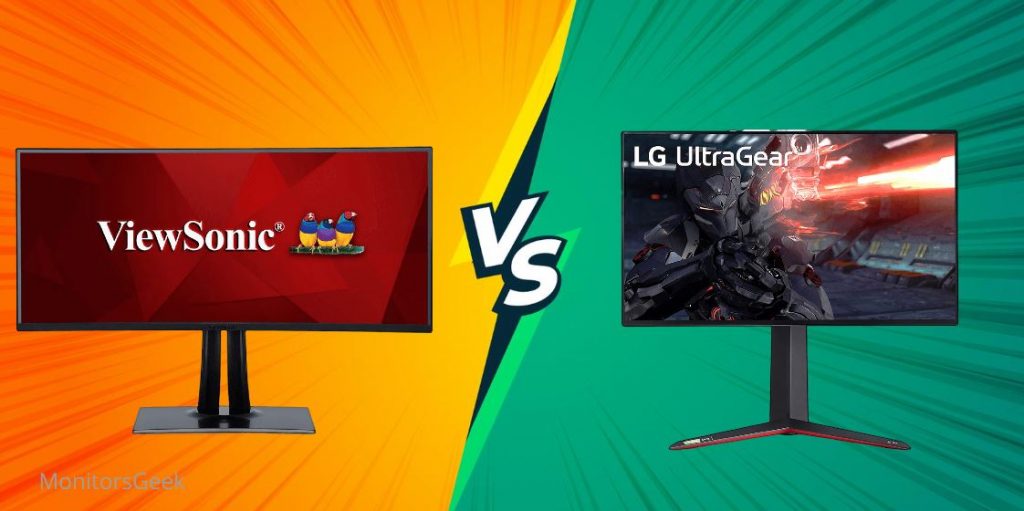Confused between choosing an UltraWide vs a 4K monitor? Let’s take a look at each resolution and see which one is better and why.

What is UltraWide?
Ultrawide monitors use 21:9 aspect ratios instead of the traditional 16:9. They follow the same ratio as 16:9 monitors. If you are unfamiliar with this aspect ratio, it has the same proportions as the traditional movie theater screen would.
It is obvious when you see an ultrawide monitor that it is different from a traditional one. Their widescreen screens (as one would expect) result in more horizontal space. For our comparison of ultrawide monitors and dual monitors, we’ll use a curved ViewSonic VP3881.
Wait…

Check out these bestselling ultrawide monitors that are selling like hotcakes right now!
[amazon bestseller=”ultrawide monitors” items=”3″ grid=”3″]What is 4K?

It’s likely that the majority prefers 4K over UltraWide (probably because it’s the format most advertised). You can find more pixels on this display than on a regular UltraWide one with its resolution of 3840×2160. This resolution is used for Ultra HD, which is commonly referred to as 4K.
What makes 4K Ultra HD so appealing is not its size. Despite the smaller footprint of 4K, it is still very impressive. Its width does not even reach 28 inches. Models in 4K Ultra HD are typically 24″ and 27″. 32-inch models are more rare than UltraWide, but they reach wide.
4K is popular because of its high resolution. In order to truly see the details in HD movies or games, it is highly advisable to use 4K. If there are more pixels available, a higher screen resolution can be achieved. You can even watch content in 1080p!
Wait…

Check out these bestselling 4k monitors that are selling like hotcakes right now!
[amazon bestseller=”4k monitors” items=”3″ grid=”3″]Picking Up a Monitor for Professional Use?
It is common for UltraWide monitors to be curved in shape. There are some flat monitors out there that you can use instead of a curved monitor if you are concerned that a curved monitor will ruin your monitor’s color accuracy.
As curved monitors focus on the above points, they do not have any problems here. You should be able to see colors regardless of where you sit and what you’re doing, but slanting lines can be difficult.
The advantage of ultrawide aspect ratios for spreadsheets is also that they add more screen space; however, setting up dual monitors with 16:9 aspect ratio is the best way to maximize your screen space.
Widescreen displays are incredibly useful for video editors, however, as they can see an expanded timeline on the display.
Best Monitor Resolution for Regular Use
Your ultra-wide monitor may seem too wide at first, but the feeling will slowly fade away. After experiencing it, you’ll wonder how you ever survived without it.
Upgrade a 32-inch screen from 1080p, 1440p to 4K, and it will still take some time to adapt to the higher resolution.
In order for icons and text to be readable, the interface will have to be scaled. The problem with some applications is that neither they play well nor they play at all, resulting in elements that are either too large or too small.
Both options have obvious disadvantages. What is the benefit of this? It is true that 21:9 ultrawide displays allow movies to display at the same aspect ratio (2.39:1) as their original format.
You can stream YouTube videos or play your favorite games in great quality with the many content options available in 4K these days.
Picking Up a Monitor for Playing Games?
Our first task will be to let you know the disadvantages of each monitor type so you can make an informed choice.
A major downside of the currently available high refresh rate 4K gaming monitors, like the LG 27GN950 4K 144Hz display, is the higher cost when running demanding games at higher, 4K resolution with reasonable frames per second.
It costs you a performance degradation to produce a high-quality image.
Likewise, you can view 3440*1440 at 100 frames per second if your computer is capable of running 4K at 60 frames per second. The frame rate difference between the two gaming setups is more significant than the image quality difference.
In addition to the wide viewing area, ultrawide monitors appear to lose some of their advantages when compared with 4K displays.
There are very few games that support the stretchable format, which results in an expansion across the screen.
Moreover, even some of the latest competitive titles do not support ultrawide formats for this very reason. Be sure that the games you love playing are compatible with a 21:9 display before you buy one.
UltraWide vs. a 4K Monitor: Which One to Choose?
You are the one who must decide which is better for your personal workflow. If you prefer to see all applications at one time, then UltraWide is for you. If you’re looking for a higher resolution, you should opt for 4K.
